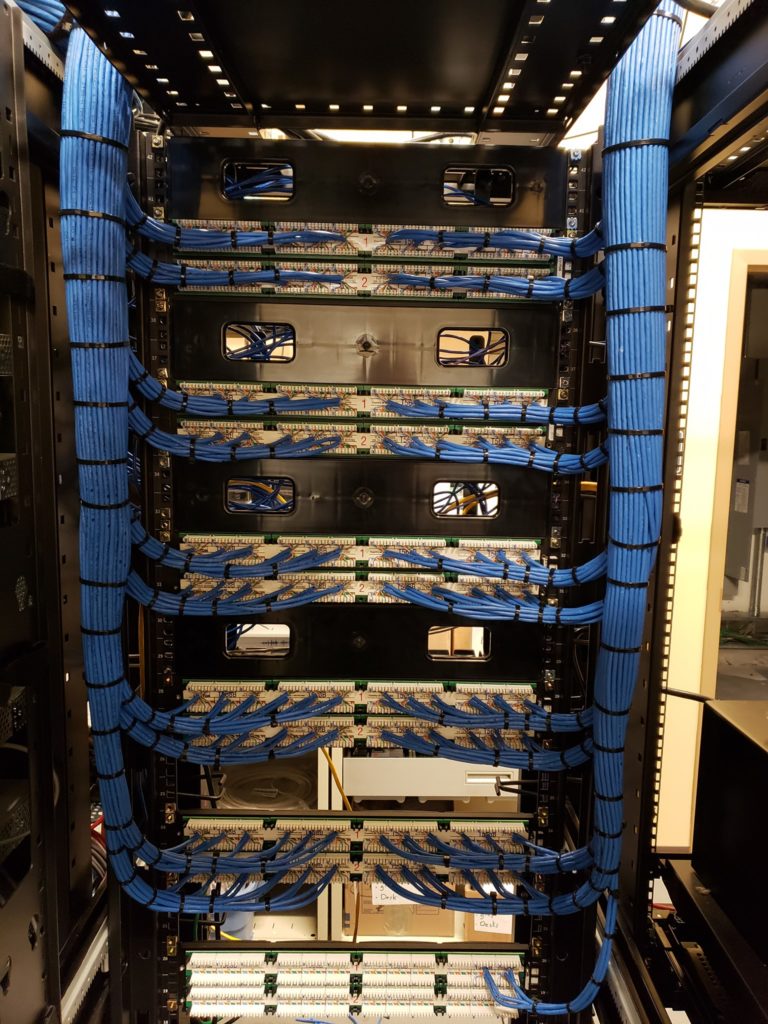Structured Cabling
No office is too big, no home is too small, Tel-Data can provide a solution for any application.
What is structured cabling?
Structured cabling is the design and installation of a cabling system that will support multiple hardware uses and be suitable for today’s needs and those of the future. With a correctly installed system, current and future requirements can be met, and hardware that is added in the future will be supported.
The standard for structured cabling is defined by the Telecommunications Industry Association (TIA) and the International Organization for Standardization (ISO). This standard includes specifications for cable types, connector types, and cable management. The most commonly used cable types in structured cabling systems are category 5e / category 6 / category 6A twisted-pair, and fiber optic cables. These cables are used to transmit data, voice, and video signals.
The image on the right shows the termination point of a buildings structured cabling installed by Tel-Data. Our technicians pride themselves in their ability to "dress" cabling into the patch panels.

For sales or service you may place your request online or call:
(352) 461-1440.

Why is structured cabling important?
Network cabling is the core of all business communications. A trained technician will meet with you to discuss industry standards, code requirements, hardware/software changes, and optimization. Whether you are building a new facility or moving and expanding your current one, Tel-Data will give you the edge you need to stay ahead of the technology curve.
Our technicians have the experience to design, install, maintain, and optimize any structured cabling system. We service and install Cat5E, Cat6, Cat6A, fiber optic cable, and coaxial cable for voice, data, and video networks. Structured cabling systems have the longest life-cycle of all your network components. Ensure your network wiring is done the right way by hiring an experienced and licensed contractor.
Is fiber considered structured cabling?
Yes, fiber optic cable is considered a type of structured wiring. Structured wiring refers to the overall system of cables and components that make up a network. This includes both copper and fiber optic cables.

What are the differences between the cable categories?
Cat5E, or Category 5 Enhanced, is an updated version of the original Cat5 cable. It has a higher maximum data transmission rate of up to 1 Gbps, and also includes improvements in crosstalk and noise resistance. Cat5E cables are commonly used for basic Ethernet networks, such as those found in homes and small businesses.
Cat6 cables are an improvement upon Cat5E, with a higher maximum data transmission rate of up to 10 Gbps. They also have better crosstalk and noise resistance, allowing for a more reliable network. Additionally, Cat6 cables have thicker copper wire than Cat5E, which improves their performance and durability. These cables are more suitable for high-bandwidth applications like video conferencing and online gaming, as well as more advanced networks in medium-size and large businesses.
Cat6A, or Category 6A, is the most advanced type of Ethernet cable currently available. It has a maximum data transmission rate of up to 10 Gbps, like Cat6, but with even better crosstalk and noise resistance. It also has a wider frequency range, which allows for even faster data transfer. These cables are often used in data centers and other high-performance computing environments, where maximum network performance and reliability are critical.
Overall, the main difference between the three types of cables is their performance capabilities, such as maximum data transmission rate, crosstalk and noise resistance, and frequency range. As the performance improves, the cable type generally increases in cost as well. Tel-Data can service and install any kind of low voltage wiring.

View more of our services:


